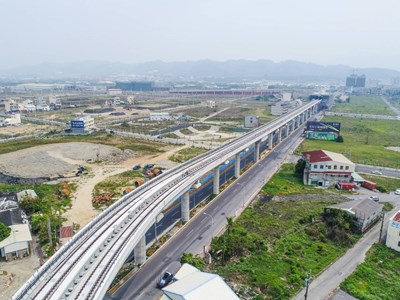
While attending public hearing at the Executive Yuan, Mayor Lin communicated his vision for the Taichung-Changhua-Nantou-Miaoli rail transport program, and he also urged the Central Government to break the mold of “Centralized resources in north Taiwan, scarce resources in south Taiwan and zero resource in Taichung” in terms of rail transport development over the years, raising awareness among various parties. On the 19th, Mayor Lin spoke with radio host Hong-yi Zheng on “Global Formosa” about major administrative policies and visions for transportation in Greater Taichung. He hopes to let everyone appreciate the necessity and outcome of rail transport promotion in Taichung.
According to Mayor Lin, Taichung features mountain and coast line railroads to connect Houli with Dajia, together with dual gauge railway from Zhuifen to Chenggong forming the “lower loop”, as well as the elevated railway linking Fengyuan to downtown Taichung and the dual gauge elevated railway along the coast line, a loop line similar to the Yamanote Line in Tokyo will be created. In particular, dual gauge railway construction from Chenggong to Zhuifen was approved by the Executive Yuan in October last year. This time, the foresight program has approved the following projects: new railway from Dajia to Houli, dual gauge elevated railway from Zhuifen to Chenggong along the coast line and elevated railway from Daqing to Wuri along the mountain line. Greater Taichung Yamanote Line is slated for completion within a decade.
Concerning the Metro Blue Line, Mayor Lin points out that Taiwan Boulevard is an extremely important thoroughfare in Taichung City, with the existing Metro Green Line passing through Wenxin Rd. and the Blue Line that passes through Taiwan Boulevard, both lines intersect to create a transfer hub. At the same time, Blue Line will be connected to the mountain and coast line railways, while the Green Line connects to Taiwan Railways at Beitun and Wuri. In doing so, an extensive railway network will be created to facilitate overall traffic volume. As regards to budget allocation, Taichung City Government strives to let the Central Government absorb 70% of the cost.
In addition, trial run for Metro Green Line will commence next year, joining Wenxin Rd. to Wuri before linking up with THSR and Taiwan Railways and extending to northern Changhua. The Green Line connects living circles in Taichung and Changhua for form joint regional governance in terms of transportation.
Radio host Hong-yi Zheng indicates that according to public opinion poll published by Apollo, Mayor Lin’s approval rating was over 30% three months after his inauguration; the figure climbed to over 40% after a year and his approval rating is now at 56.1%, demonstrating an upward trend. In other words, the citizens of Taichung have begun to appreciate the transformations and advances that have taken place in the city. For Executive Yuan’s foresight program, Taichung has been approved NT$ 159.7 billion; why does Mayor Lin believe that receiving approval for foresight program suggests that “opportunities are reserved for those who are prepared”?
According to Mayor Lin, before becoming a Mayor he was involved in grassroots development in Taichung for more than a decade. Now second year into his tenure, he believes that that the local government has done as much as it can, but the foresight program requires drawing up a budget and plan, therefore the City Government has completed relevant evaluation plans and submitted them to the Central Government. Many of the projects are highly feasible. Furthermore, many of Taichung’s infrastructures are comparable to Taipei; for instance, Taipei’s 4 metro lines were paid for by the Central Government, Kaohsiung’s 2 metro lines adopted a BOT approach, with investments coming from the private sector, which is responsible for the project’s profit and loss. Taichung only has one metro line, thus the foresight program is to compensate Taichung for the lack of resources in the past and bring the city in line with the next wave of developments in Taiwan. This is called “transport justice”.
Moreover, Hong-yi Zheng commended Mayor Lin for implementing numerous “invisible infrastructure”, such as the dredging of Riyue Lake in Taichung Park. Mayor Lin indicates that although Taichung Park is extremely popular among the public, over the years the Riyue Lake has silted up with mud, emitting foul smell. After the City Government dredged the lake, the water quantity and quality have both improved dramatically, and Riyue Lake no longer gives off stench or suffers from eutrophication. The upshot of this is that more people are attracted to the lake for rowing and other leisure activities. In the future, waste water will be pumped to nearby water treatment plant to become reclaimed water.
In addition, there is also the new spotlight in Taichung – Liu River. Due to urban development, a large amount of waste water is discharged into Liu River, resulting in unbearable stench, hence the City Government devised plans to rectify the problem, including: sewage interception, water treatment plant, water storage compartments at the bottom of the river and plantation of deodorizing grass using ecological engineering technique. As a result, schools of fish and flocks of egrets have returned to the river. Green slopes are created on both sides of the river to enhance its functions as a waterfront recreational venue. Besides senior citizens from nearby nursery homes, visitors are also flocking to the Liu River to enjoy the leisurely ambiance, in turn fostering the business of nearby stores.
Hong-yi Zheng also touched on Mayor Lin’s statement to the Central Government about air pollution generated by Taipower. According to Mayor Lin, thermal power plants in Taichung generate 20% of Taiwan Power Company’s total output; although the profits generated are handed over to the Taipei headquarters, Taichung citizens are the ones suffering from the emissions. Currently, the City Government has negotiated with Taipower to reduce load and carbon emissions, while coals must be stored indoors and air-pollution treatment facilities improved. At the same time, it is hoped that the Central Government will facilitate the replacement of coals with natural gas for power generation purposes, and the equipment should be renewed, just as the Linkou Thermal Power Plant has done in order to minimize pollution.

 Facebook
Facebook
 Twitter
Twitter
 LINE
LINE